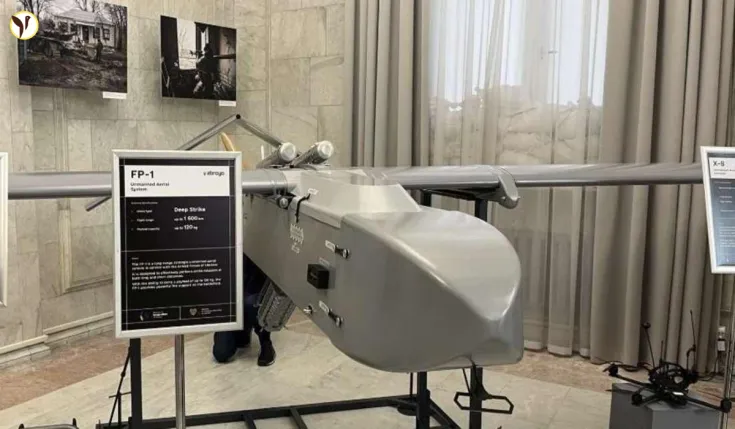Ukraine Unveils New Long-Range Drone: A Game Changer in the Russia-Ukraine War?
The conflict in Ukraine continues to evolve rapidly, with both sides employing increasingly sophisticated weaponry. Recently, Ukraine unveiled a new long-range drone, the UAC FP-1, potentially shifting the dynamics of the war. This article delves into the capabilities of this new weapon, its implications for the conflict, and the ongoing diplomatic efforts to bring about a ceasefire.
Ukraine's New Weapon: The UAC FP-1 Drone
Reports indicate that Ukraine has introduced the UAC FP-1, a large, long-range kamikaze drone capable of carrying a significant payload. Analysts from the Foundation for Defense of Democracies (FDD) suggest the drone can transport a 120-kilogram warhead. Its reported range of up to 1600 kilometers is particularly noteworthy, allowing strikes deep within Russian territory.
- Key Features: The FP-1's design notably omits landing gear, unlike previous models. It launches using a rocket-assisted takeoff from an angled ramp, enhancing its range and reducing vulnerability during takeoff. Videos circulating online appear to show this launch method, though independent verification is pending.
- Production: The drone is manufactured by the Ukrainian-Czech arms company UAC, with production taking place in Czech Republic, away from the immediate threat of Russian airstrikes. This strategic location ensures a continued supply of this vital weapon.
- Combat Use: Forbes reports that the FP-1 has already been deployed in combat, highlighting its immediate impact on the battlefield. Its reported range has the potential to significantly increase Ukraine's ability to target key Russian infrastructure and military assets.
The emergence of the UAC FP-1 adds to Ukraine's existing arsenal of long-range drones, such as the "Ninja" and "Liutyi," which have already been used to strike targets far behind Russian lines. The FP-1’s increased range and payload capacity significantly increases the pressure on Russia. The impact of this weapon system is yet to be fully assessed, but its potential to disrupt Russian operations is undeniable.
Ongoing Diplomatic Efforts and Ceasefire Talks
Amidst the escalating conflict, diplomatic efforts continue toward a potential ceasefire. Recent developments include:
- Putin's Proposal: Russian President Vladimir Putin has expressed a willingness to engage in talks, suggesting a meeting in Turkey. However, he has yet to publicly respond to Ukraine's proposal for an unconditional ceasefire. Russia's continued attacks, including a recent drone attack on Kyiv, cast doubt on their commitment to a genuine peace process.
- Western Demands: European leaders and the United States have jointly called for a 30-day unconditional ceasefire as a prerequisite for meaningful negotiations, a demand that Russia has rejected. The West has suggested that additional sanctions will be imposed on Russia if they fail to agree to the ceasefire.
- Selenskyy's Stance: Ukrainian President Volodymyr Zelenskyy has shown a willingness to engage in talks but insists on a prior unconditional ceasefire by Russia. This reflects Ukraine’s deep mistrust of any agreement made without a concrete demonstration of Russian commitment to cease hostilities.
- Trump's Involvement: US President Donald Trump has played an active role in the diplomatic efforts, offering suggestions and pressuring both sides towards a resolution. His involvement underlines the continued US investment in the conflict and their influence over potential peace talks. His stance on potential compromises has shifted during the negotiation process.
The current situation is characterized by a significant divergence in approaches. While some express optimism about the possibility of direct talks, others remain skeptical given Russia's track record of broken promises and continued aggression. The possibility of a longer-term ceasefire remains unclear, dependent on both sides finding common ground. The development and deployment of the UAC FP-1, however, provides Ukraine with significant new leverage in this complicated diplomatic landscape.
Conclusion: A Precarious Path to Peace
The introduction of the UAC FP-1 drone represents a significant development in the Russia-Ukraine war, potentially altering the balance of power on the battlefield. Simultaneously, the ongoing diplomatic efforts highlight the complexities and challenges of achieving a lasting peace. An unconditional ceasefire remains a critical prerequisite for meaningful negotiations, and the international community's continued pressure on Russia to uphold its commitments is paramount.
The future of the conflict hinges on Russia's willingness to engage in good faith and on the international community's ability to maintain sustained pressure for a lasting resolution.






